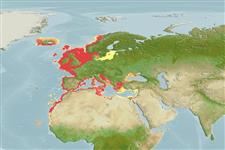Bivalvia |
Pectinida |
Pectinidae
Environment: milieu / climate zone / गहराई सीमा / distribution range
पारिस्थितिकी
; गहराई सीमा 0 - 200 m (संदर्भ 2754). Subtropical, preferred 16°C (संदर्भ 107945); 69°N - 15°N, 25°W - 36°E (संदर्भ 78075)
Eastern Atlantic, Mediterranean and Black Sea: Norway to Senegal and Turkey.
Length at first maturity / आकार / Weight / Age
परिपक्व अवधि: Lm ? range ? - ? cm Max length : 10.0 cm SHL पुल्लिंग / अलिंग; (संदर्भ 109255); अधिकतम सूचित उम्र: 7 वर्षो (संदर्भ 8702)
Minimum depth from Ref. 114500. This is a sessile-burrower, suspension feeder (Ref. 96498).
Life cycle and mating behavior
परिपक्व अवधि | पुनरुत्पत्ति | मछलीऔ का अंडे देना | Eggs | Fecundity | Larvae
Members of the class Bivalvia are mostly gonochoric, some are protandric hermaphrodites. Life cycle: Embryos develop into free-swimming trocophore larvae, succeeded by the bivalve veliger, resembling a miniature clam.
Demir, M. 2003 Shells of mollusca collected from the seas of Turkey. Turkey Journal of Zoology 27:101-140. (संदर्भ 2754)
IUCN Red List Status
(संदर्भ 130435: Version 2025-1)
CITES status (संदर्भ 108899)
Not Evaluated
CMS (संदर्भ 116361)
Not Evaluated
Threat to humans
Human uses
मात्स्यिकी: व्यापारिक
| FishSource | Sea Around Us
साधन
अधिक जानकारी
Life cycleपुनरुत्पत्तिपरिपक्व अवधिFecundityमछलीऔ का अंडे देनाEggsEgg developmentLarvae PhysiologyOxygen consumption
इंटरनेट स्रोत
Estimates based on models
Preferred temperature
(Ref.
115969): 11.3 - 16, mean 13.8 (based on 32 cells).
लौटाव
ऊंचा, न्यूनतम जनसंख्या दुगनी समय अवलागत 15 महीने। (K=0.57; tmax=7).
Fishing Vulnerability
Low to moderate vulnerability (29 of 100).
Climate Vulnerability
Moderate to high vulnerability (54 of 100).
Nutrients : Calcium = 149 [71, 228] mg/100g; Iron = 8.53 [1.95, 15.11] mg/100g; Protein = 9.88 [8.64, 11.12] %; Omega3 = 0.313 [0.202, 0.423] g/100g; Selenium = 61 [50, 72] μg/100g; VitaminA = 0 μg/100g; Zinc = 2.04 [0.56, 3.51] mg/100g (wet weight); based on
nutrient studies.
